
15 minute read
ARTISTIC ABODE
Ralph and Allyn Froshin cultivate happiness at their Lake Martin home
STORY BY LONNA UPTON & PHOTOS BY KENNETH BOONE
AAlexander City native Ralph Frohsin and his wife, Allyn, are known by locals as enthusiastic supporters of their city, the arts and Lake Martin. In their years together, they have enjoyed their lives on the lake and created a home that is exquisitely happy.
“When we built the house in 1978 we were in kind of a brown mode, but through the years that has changed. Now people come in, love the colors and say this is a happy house,” Allyn Frohsin said. Birmingham contemporary architect Fritz Woehle designed the home for the couple. Woehle’s original design had the house on stilts over the lake. Next, the design had four pods, distinctly separate parts of the house, sitting on a deck but not connected at all. The final design connected the four pods with an open-air atrium in the center, which Woehle wanted to be completely natural, as if the home were set down into the woods. Avid art lovers, the Frohsins have taken advantage of travelling and paid close attention to articles they read in American Crafts magazine to find the perfect accessories for their home. They commissioned Sarah De Barry, Renaissance Glass Company in Austin, Texas, to design stained glass for the front doors. After sending DeBarry a photo of their foyer rug, the stained glass was beautifully created to complement the rug and set the stage for the entire home.
At Woehle’s insistence, the walls and ceilings in the entire home are painted white, and the large foyer extending into the main living area is white marble from Sylacauga. Around the foyer and main living area, abstract art, paintings and sculptures, mixed media, stone and glass, most in primary colors, paint a breathtaking glimpse into the Frohsins’ love of creative arts.
“The architect said we would never need to change the paint color on the walls and ceilings, that we would just need to change what’s around it, so that’s what we have done. Everywhere we traveled we were always looking for art – paintings, glass, birds or sculpture. We just bought what we liked,” Frohsin said.
The foyer features artwork by Myra Burg that the Frohsins saw in a magazine – PVC pipes of different lengths are wrapped in silk threads and stand as towers. The couple contacted the artist who sent
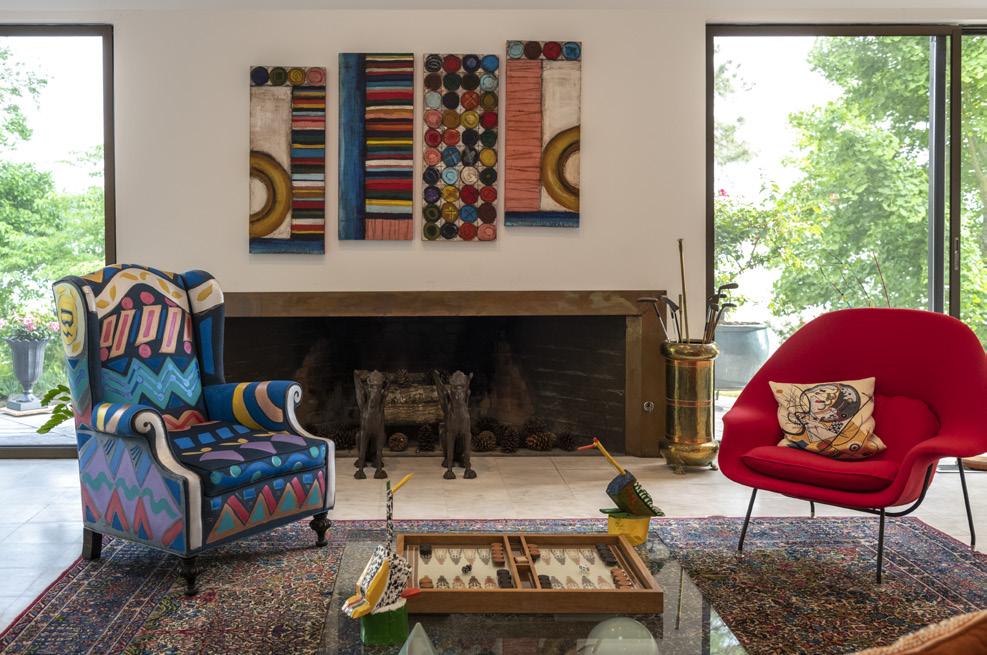
A fading armchair complements the artwork Roses and the lake are part of every view from the home
Artist Sarah De Barry designed the stained glass in the front doors to complement the foyer rug

The home was designed by architect Fritz Woehle to appear as if it had been set down in the woods



several from which to choose. They kept the group, as they liked the way they looked together. A vertical work of art, bright strips of silk sewn together, created by Toby Klein, was purchased at the Children’s Harbor Art on the Lake event.
Around the atrium, the Frohsins have pedestals displaying a bowl of industrial steel found in Carmel and a bowl made from Tallapoosa County soapstone crafted by an Alabama artist. A full-sized papiermache statue of Venus, found in New Orleans, is a favorite purchase and is often dressed for Mardi Gras or with other seasonal pizzazz. A three-panel painting of brightly colored fish by local artist Lila Graves hangs across from the atrium. Frohsin displays exquisite needlepoint, executed by her mother and herself, including intricate, colorful geometric designs by Victor Vasarely down one hallway.
The Frohsins designed their home with a guest room and bathroom, an office, a master bedroom and two master bathrooms, one for him and one for her. The two bedrooms and the main living room have lake views and open through sliding doors to the deck. The office contains a large desk and shelving built by Gregory Griffith in Kellyton. The shelves allow space for Ralph’s favorite history books plus arrowheads and old shards of pottery he has found around the lake. The guest room has a handcrafted bed with lips on the headboard and end tables to match with shoes for feet, designed and built by Dale Lewis from Calera, Alabama. Carolyn Heller, Ralph’s sister, painted the
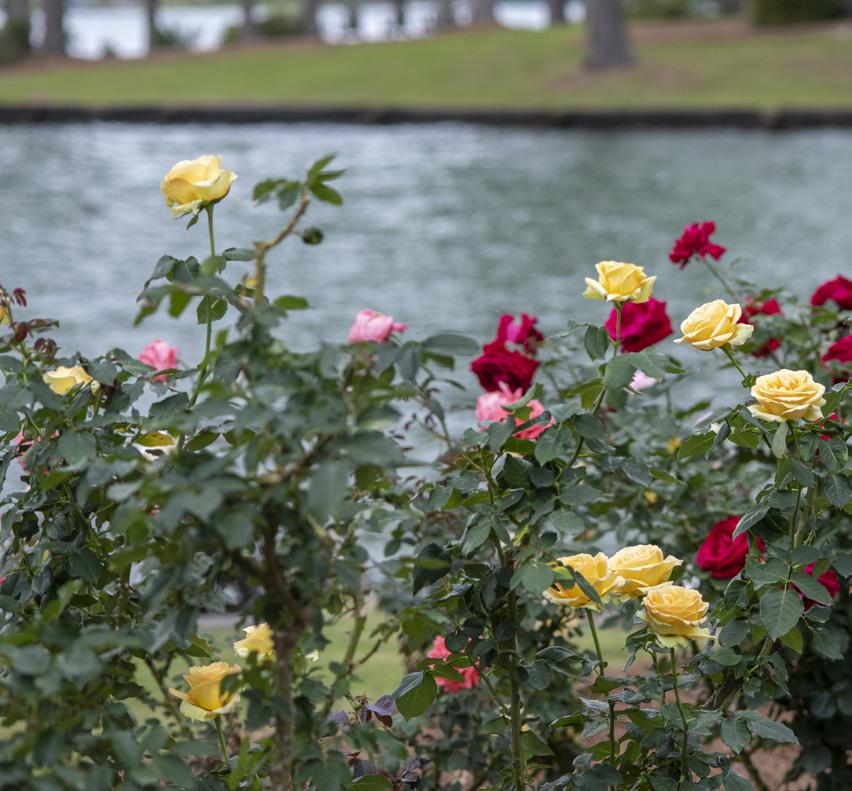
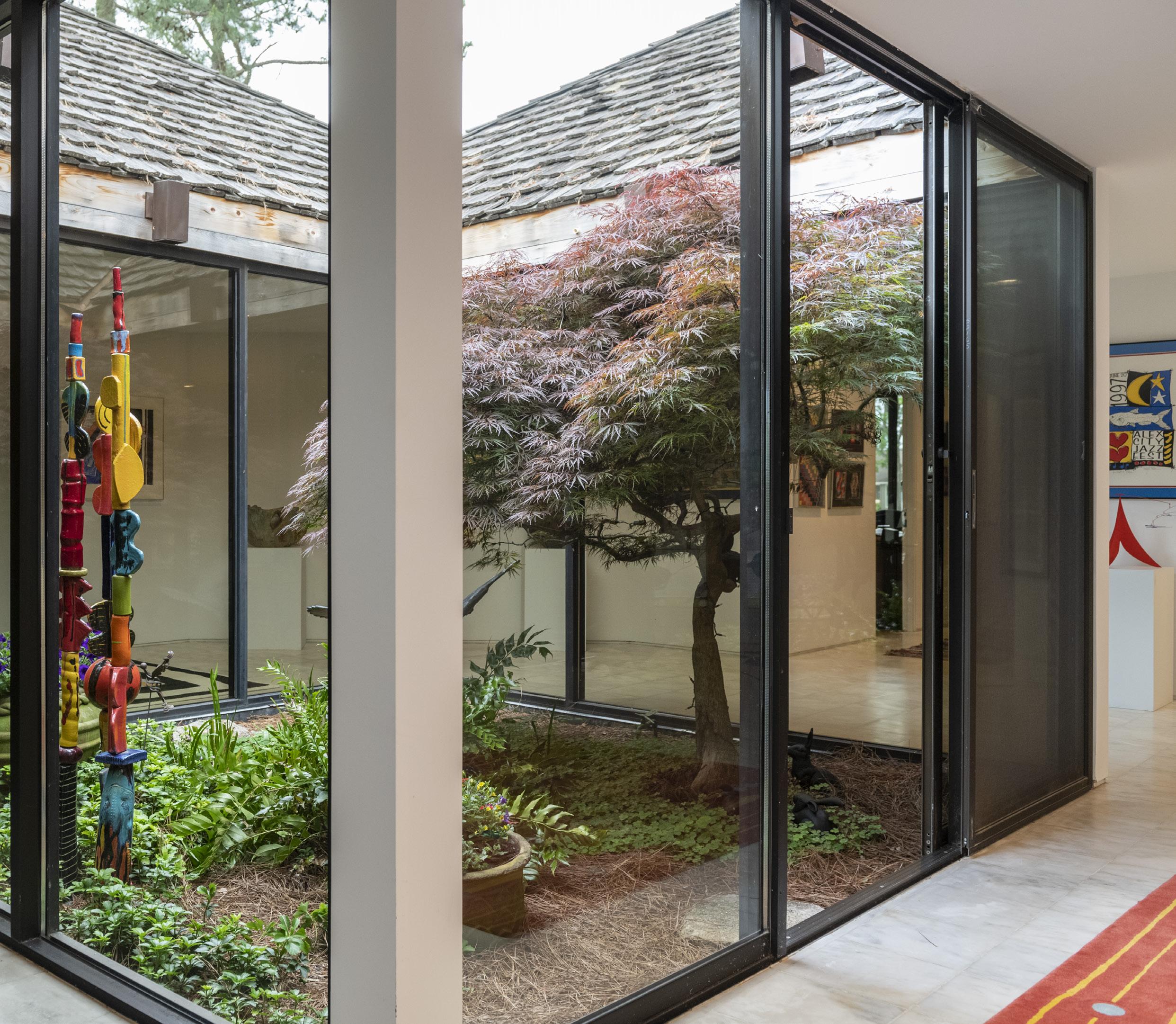


Clockwise from facting page top left: Local artist Lila Graves painted the brightly colored fish panels; The center atrium offers a different view from each of the four pods that surround it; Bar stools by Bill Palmer offer seating at the bar, a reclaimed countertop; Roses are a passion Ralph inherited from his father, Ralph Frohsin, Sr.

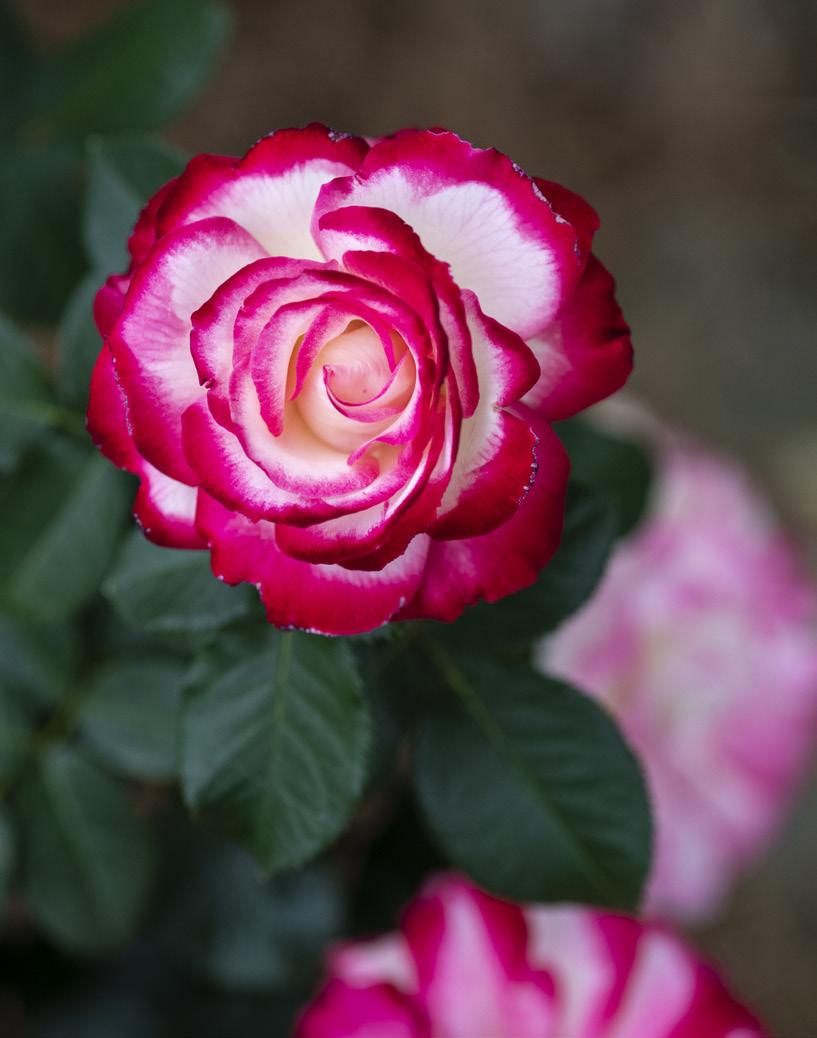
Moonstone Cherry Parfait

St. Patrick Garden Party We Salute You


Olympiad Veterans' Honor



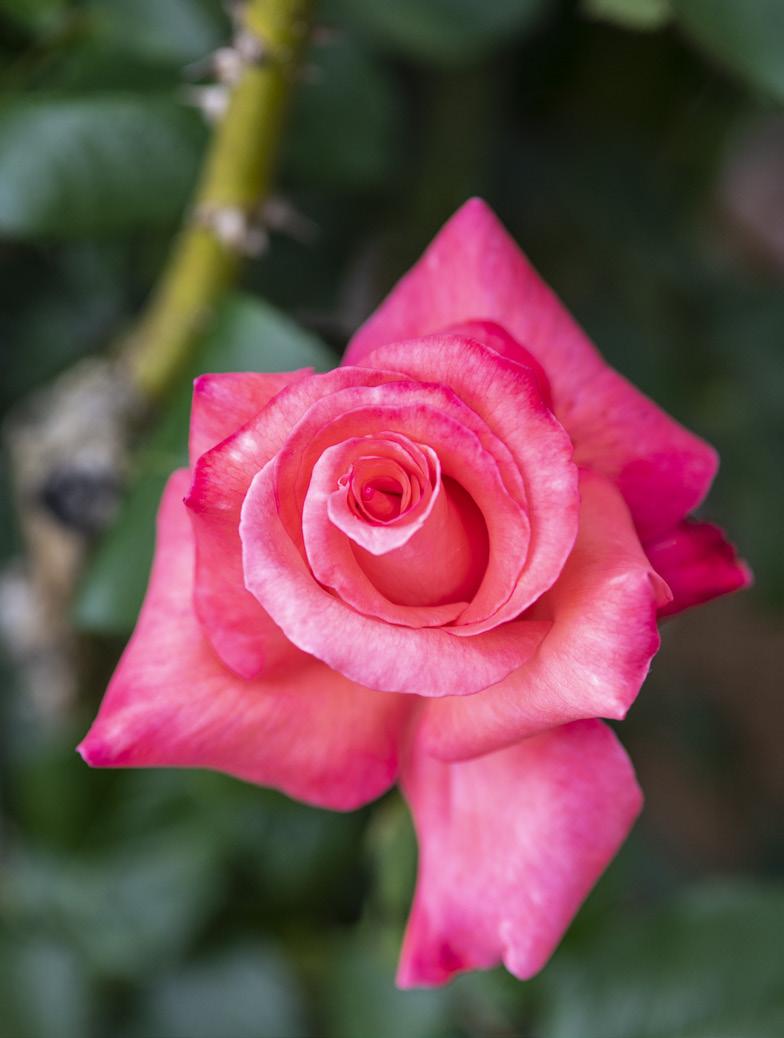
Elizabeth Taylor
Dale Lewis built the whimsical headboard with lips and side tables standing on high-heeled shoes
guest bathroom. After asking the couple to hang white linen wallpaper, she spent a weekend there, creating a patchwork design of hearts, florals, geometric designs and fish on the walls and shower curtain.
While designing their home, their architect suggested the Frohsins visit George Nakashima of Nakashima Woodworkers in New Hope, Pennsylvania, to pick out special pieces of furniture for their new home. Nakashima personally took them around to pick out specific pieces of wood for a headboard, night tables, a card table and chairs. These pieces still remain some of their favorite purchases.
“Although we like contemporary style and abstract art, we also have antiques mixed in. We bought a glass-topped multi-color dining room table in New York, but I had my grandmother’s antique chairs, so we mixed those with the table. My mother and I did the contemporary needlepoint on the seats,” she said.
The glass-walled atrium, the centerpiece of the home and a work of art in itself, began by enclosing just the woods. A mix of lush groundcover, potted flowers and a Japanese maple tree merge with a colorful sculpture from a Minnesotan folk artist named Russ Vogt along with a blue heron fountain from Robinson Iron.
A modern low sectional sofa and a glass-topped coffee table anchor the living room in front of a large fireplace where painted panels from an artist in LaGrange, Georgia, are the focal point. The Nakashima game table with unique Conoid two-legged chairs finish the corner of the room near the glass doors onto the deck. A large glass bowl by Cal Breed of Orbix Hot Glass in Ft. Payne, Alabama, adorns the table. Along one wall, a shelf unit with cabinetry and shelves holds a collection of glass – birds, glasses and other pieces of art glass that the Frohsins have collected from around the world in New Zealand, Finland, Sweden, Nova Scotia, Copenhagen, Russia and Venice.
The bar was original to a general store in Tennessee. The top was stained and varnished and the base painted white to blend with the room. Mirrored shelves behind the bar offer an expansive view of the room. Barstools with driftwood accents were created by Alabama artist Bill Palmer.
“I love driftwood, picking it up when I see it, and have it here and there in the house. I think it really is God’s sculpture,” Ralph said.
Having served for many years on the Alabama State Council on the Arts, he developed a great interest

The living area features a comfortable, low sectional surrounded by contemporary art and furniture

in Alabama art and artists. In 1991, to celebrate the 100th anniversary of Frohsin’s, he thanked the community by holding the first Jazz Fest in Alexander City, which was free to the community. It was such a popular event that it grew into a twoday festival and has continued for 30 years. Ralph proudly displays posters from every year of the festival.
Ralph’s interests expanded to the outdoors in 1982 when his father sent his gardener to plant four rose bushes. A hobby his father may have begun for the Frohsins has now grown to 138 bushes in 72 varieties. The roses are in view on the shores of Lake Martin for everyone to enjoy.
“I can’t choose a favorite. That’s like asking a parent to choose a favorite child. I will say they are not hard to grow. They need a lot to drink and a lot to eat. In the spring, I remove all the old pine straw and dead leaves, break the soil up around each bush with a garden fork and add fertilizer to condition the soil. Then I put out new pine straw,” he said.
In 2015, the Frohsins came home from a vacation to discover that beavers had taken out all or part of 80 bushes. Frohsin prunes his roses to chest high, but the beavers had pruned to ankle high. After traps failed to work, Ralph contacted a game warden that suggested a low-voltage double wire around the edge of the lakeside. The wire, which only comes on at night, solved the problem. Within a few weeks, the roses were sprouting new growth, bringing much joy to the gardener – Ralph.
Tucked into this bit of paradise on Lake Martin are rare jewels – the rose garden paths, an amazing tribute to art and the couple themselves. Happiness abounds.
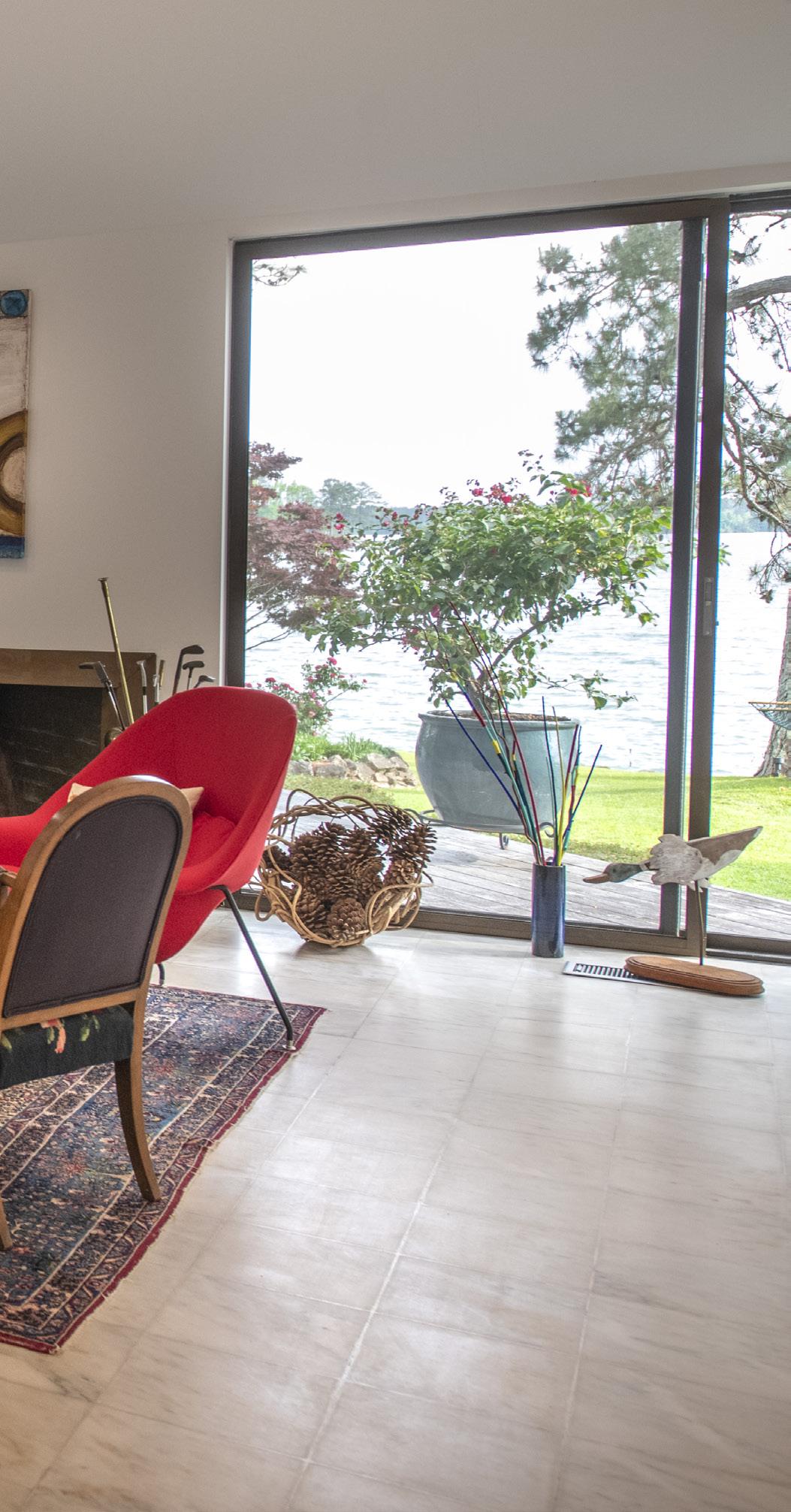

The property displays the rose garden for lakegoers to enjoy
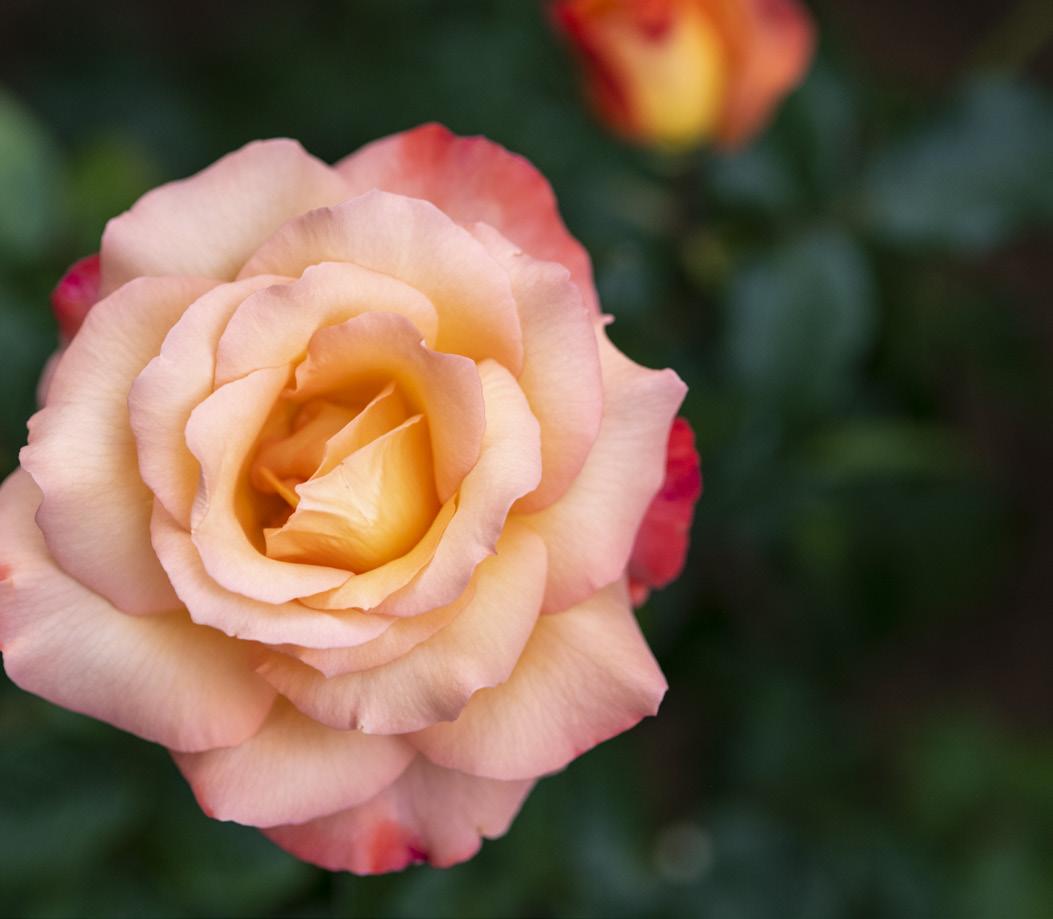
Mercury Rising
Frohsin's needlepoint makes a beautiful statement in the bedroom

Eastern Screech-Owl
TThere’s a tiny predator in the woods around Lake Martin that is a common, year-round resident but – because it is nocturnal, secretive and superwell camouflaged - you’ve probably never seen it. Even if you looked right toward it.
While the Eastern Screech-Owl is not the most obvious bird that comes to mind when you think of a raptor, it is a small, opportunistic and efficient hunter that uses its beak and needle-sharp talons to capture a very wide range of prey, including insects, fish, lizards, snakes, frogs, earth worms, soft shell turtles, crawfish, salamanders, moths, cicadas, chipmunks, squirrels and other birds, including quail, woodcock, pigeons and even sparrow hawks. The Screech-Owl’s favorite prey seems to be small rodents, like mice. This bird is very small for an owl, roughly the size of a robin. It’s about 6-1/2 to 9-1/2 inches tall and weighs about a third of a pound, with the male weighing about an ounce less than the female. The bird is short and stocky with rounded wings and no visible neck. Its beak is gray fading to pale yellow, and the eyes are bright yellow. An obvious identifying feature is the tall, pointed feathers on top of its head called “ear tufts.” The Eastern Screech-Owl is the smallest owl in the eastern U.S. with ear tufts, and this owl often keeps his “horns” raised. Eastern Screech-Owls have two color phases, red and gray. Both can show up in the same brood, like a family with one blond child and one brunette, but the red phase is more common in the Southern U.S. Red phase coloring ranges from bright red to rusty brown. Both phases have streaks and complex patterns of dark and light feathers, which help these owls seem to disappear against tree bark. Although these owls are very much creatures of the night, at times you may see them sitting motionlessly during daylight hours in the nook of a tree, depending on their camouflage to protect them. Eastern Screech-Owls tend to stay in dark areas during the day unless sunning, when they face the sun and squint or close their sensitive eyes. These owls hunt from dusk to dawn, with the most activity in the first four hours of the night. They hunt mostly from a perch, diving to capture their prey, but occasionally will hover as they search for dinner. Eastern Screech-Owls have been seen catching insects on the wing. Bite-size prey is swallowed whole while larger animals are taken to a perching spot where the owl uses its beak to tear the prey into smaller pieces.
They are found around water, especially along lake shores with hardwood forests, in open woodlands, near old barns and even in suburban areas from the Gulf Coast to Canada east of the Rocky Mountains.
Nicknames can often be misleading; the biggest guy in Sherwood Forest was called “Little John.” In the same vein, Screech-Owls don’t usually screech; instead, they make some of those low, soft, comforting, familiar evening forest sounds that you’ve probably heard over and over. Their calls sound more like those of the laid-back mourning doves’ coo than a scary bobcat scream. The only time you would hear one of these owls actually screech is when they are defending their nests or fledglings.
Other names for this little owl are a little more accurate: whinnying owl, shivering owl, whickering owl, red owl, gray owl, little cat owl, little dukelet, scritch owl, squinch owl, mottled owl and little horned owl. Its scientific name is Megascops asio, which means “horned owl” in Latin.
The Screech-Owls’ two main calls are a whinny, which sounds sort of like a quiet horse whinny that lasts half a second to two seconds, and a longer trill that lasts three to six seconds. The whinny is used to keep families of owls in contact, and the trill is used to defend territories. It’s voice is variously described as a tremulous, descending wail with soft purrs; a bounce song and a mellow, muted trill. That probably doesn’t help much – it’s difficult to describe animal sounds with words – but there are plenty of recordings online that will make it clear that Little John doesn’t usually screech. If you’d like to hear this bird’s calming call, search for Eastern Screech-Owl Sounds on allaboutbirds. com.
Interestingly, even though a male Screech-Owl is physically smaller than a female, his voice is the deeper of the two. You are most likely to hear
The Screech-Owl is a small raptor that doesn't really screech
NATURE OF THE LAKE
BY KENNETH BOONE

Eastern Screech-Owl calls on spring and fall evenings.
If you’d like to see them, here’s a trick: Listen for a commotion of other birds. When songbirds spot a Screech-Owl, they will sound off enmass and “mug” the owl to encourage it to relocate. In fact, most of the time when you hear a bunch of birds calling excitedly and loudly, they are trying to chase off a raptor or some other predator threatening their nests.
Another way to get a peek at a Screech-Owl is to install a nesting box on your property. Screech-Owls readily choose to nest in man-made boxes that are the right size and offer protection from predators. You can find plans to build a Screech-Owl nesting box at Cornell University’s nestwatch.com. Screech-Owls will also visit bird baths to bathe and drink, so it’s not a bad idea to install one of those, too.
During the spring breeding season, males approach females while calling to them from different perches. When they get close, the guy will go into a mating dance that involves bobbing and swiveling his head and then his entire body, increasing the intensity of his dance until he catches her attention. He will then wink one eye slowly at his future partner. If the gal approves, the two will move close together and touch beaks and groom one another before mating. These owls mate for life, but if one partner disappears, the other will find a new mate.
Eastern Screech-Owls nest in hollows in trees or boxes or even stumps with no nest lining. They often reuse old nests chiseled into dead trees by Pileated Woodpeckers and Northern Flickers. Most nesting sites are 6 feet to 20 feet above the forest floor, and the cavities are often used year after year. Most broods begin in the spring with three to four small, round or oval eggs. After a 26-day incubation period when the female sits on her eggs and the male brings her food, the chicks hatch out. It will be another month before the young owlets can fly, and during that time the male continues to hunt and provide food for his family. The young owls are dependent on both parents for at least another month after that. When there are eggs or hatchlings involved, screech owls aggressively defend their nests and may attack anything, including people that come too close. The trauma of being dive-bombed at night by a screeching owl is probably where this bird’s name came from, though it is not a common occurrence.
The red phase Eastern Screech-Owl pictured here is named Trayne. It suffered head trauma after striking a train and is now being cared for by the Teton Raptor Center in Wilson, Wyoming, where it participates in raptor education programs.
In captivity, Eastern Screech-Owls have lived for 20 years. The oldest owl found in the wild was tagged more than 14 years earlier. Most wild owls live much shorter lives with juvenile mortality rates approaching 70 percent and adults 30 percent. Eastern Screech-Owl predators include raccoons, skunks, snakes, crows, Blue Jays and larger owls.

Owlets from the same brood could be gray or red
Some information for this article came from outdooralabama.com, ebird.org, Cornell University’s allaboutbirds.org and owlpages.com.











